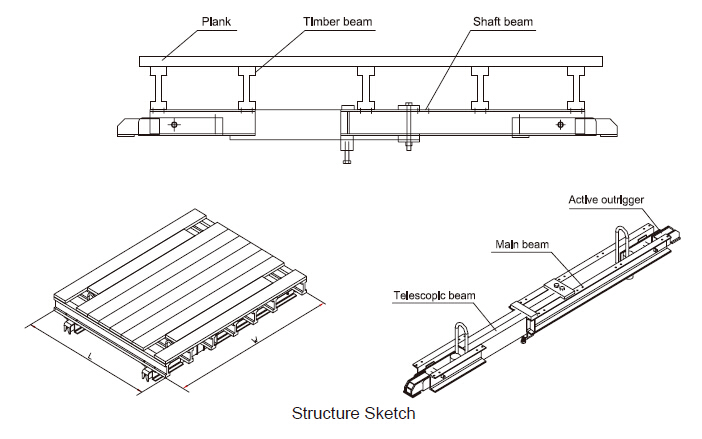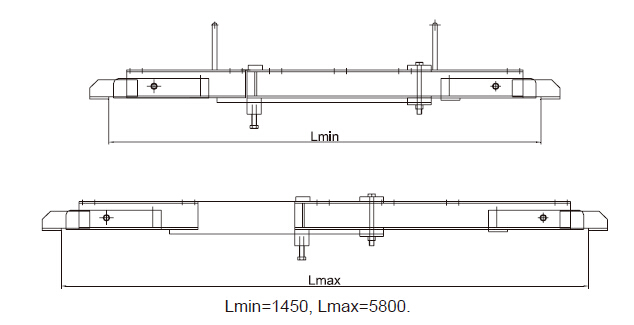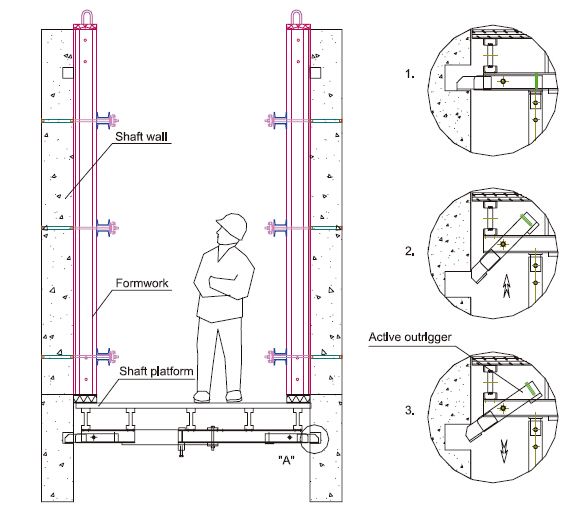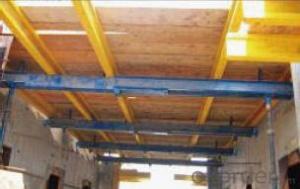Shaft Platform for Formwork and scaffolding system
- Loading Port:
- Tianjin
- Payment Terms:
- TT OR LC
- Min Order Qty:
- 50 m²
- Supply Capability:
- 1000 m²/month
OKorder Service Pledge
Quality Product, Order Online Tracking, Timely Delivery
OKorder Financial Service
Credit Rating, Credit Services, Credit Purchasing
You Might Also Like
Shaft Platform
As operating platform, the shaft platform is mainly used in the concrete pouring of elevator shaft,
equipment shaft, stair shaft of high-rise building and so on.
Characteristics:
◆ The length of shaft beam is adjustable.
◆ Flexible structure makes lifting easier.



- Q:What are the factors to consider when selecting steel formwork for a project?
- When choosing steel formwork for a project, there are multiple factors that need to be taken into consideration. To start with, the size and complexity of the project should be evaluated. The steel formwork should be able to accommodate the specific dimensions and requirements of the project. It is important to consider the shape and design of the structure, as well as any unique features or details that may necessitate customized formwork. The strength and durability of the steel formwork are crucial aspects to consider. It should be able to endure the weight and pressure of the concrete during pouring and curing. Desired characteristics include high load-bearing capacity and resistance to deformation. Additionally, the formwork should be able to resist rust and corrosion, particularly in areas with high levels of humidity or exposure to water. The ease of assembly and disassembly is another important consideration. Opting for steel formwork that can be quickly and efficiently put together and taken apart can save time and reduce labor costs. The formwork should have a user-friendly design, accompanied by clear instructions and requiring minimal tools for installation. Compatibility with other construction equipment and processes, such as cranes or concrete pumps, should also be taken into account. The reusability of the steel formwork is another factor to consider. If the project requires multiple pours or if there are future projects that could benefit from the same formwork, it is important to select formwork that can be easily dismantled, cleaned, and reused. This not only reduces waste and environmental impact, but also provides long-term cost savings. The availability and cost of the steel formwork should also be considered. It is crucial to choose a supplier or manufacturer that can deliver the required quantity of formwork within the project's budget and timeframe. Comparing prices and quality from different suppliers can aid in selecting the most cost-effective option. Lastly, safety should always be prioritized. The steel formwork should meet all necessary safety standards and regulations. It should be stable, secure, and capable of withstanding potential accidents or mishaps during the construction process. Additionally, the formwork should provide adequate protection for workers, such as guardrails or safety nets, to prevent falls or injuries. By taking these factors into account, the selection of steel formwork for a project can be carried out in an informed and efficient manner, ensuring the success and quality of the construction process.
- Q:Can steel formwork be used for both above-ground and underground structures?
- Yes, steel formwork can be used for both above-ground and underground structures. Steel formwork offers several advantages such as high strength, durability, and reusability, making it suitable for various construction applications. For above-ground structures like high-rise buildings or bridges, steel formwork provides the necessary support and stability during the casting of concrete. It can be easily assembled and disassembled, allowing for efficient construction processes. Similarly, for underground structures like tunnels or basements, steel formwork can withstand the pressures exerted by the surrounding soil and water. It helps in maintaining the required shape and dimensions of the structure until the concrete sets and gains sufficient strength. Moreover, steel formwork can resist corrosion, which is crucial for underground structures exposed to moisture and other environmental factors. Overall, steel formwork is a versatile solution that can be used effectively in both above-ground and underground construction projects.
- Q:How does steel formwork affect the overall acoustic properties of the structure?
- Steel formwork does not significantly affect the overall acoustic properties of a structure. Steel formwork refers to temporary structures made of steel panels that are used to hold concrete in place during the construction process. These formwork systems are usually removed once the concrete has hardened. The acoustic properties of a structure are primarily determined by the materials used in the permanent construction elements, such as walls, floors, and ceilings. Steel formwork is not a permanent part of the structure and does not contribute to its acoustic properties. However, it is important to note that during the construction process, steel formwork can create temporary noise and vibrations due to the handling of the steel panels, as well as the pouring and compacting of concrete. These construction activities can generate noise that may impact the acoustic environment in the immediate vicinity of the construction site. However, once the formwork is removed and the structure is completed, the steel formwork itself does not have a significant impact on the overall acoustic properties of the building.
- Q:Can steel formwork be used in coastal or marine construction projects?
- Yes, steel formwork can be used in coastal or marine construction projects. Steel formwork is known for its durability and strength, making it a suitable choice for projects in harsh environments such as coastal or marine areas. Its resistance to corrosion allows it to withstand the corrosive effects of saltwater and other coastal elements. Additionally, steel formwork can be easily reused and recycled, making it a cost-effective and sustainable option for coastal or marine construction projects.
- Q:How does steel formwork affect the overall cost of a construction project?
- Steel formwork can have a significant impact on the overall cost of a construction project. Although the initial cost of steel formwork may be higher than other types of formwork, it offers several advantages that can lead to cost savings in the long run. Firstly, steel formwork is highly durable and can be used repeatedly, making it a cost-effective option for multiple construction projects. Unlike other formwork materials such as wood, steel does not warp or degrade over time, reducing the need for costly replacements or repairs. Additionally, steel formwork provides enhanced structural stability, ensuring accurate and precise concrete placement. This results in reduced material wastage and a more efficient use of resources, ultimately lowering construction costs. Moreover, steel formwork offers faster assembly and disassembly times compared to traditional formwork materials. The quick installation and removal process can significantly reduce labor costs and the overall duration of the project, allowing for increased productivity and potentially saving on overhead expenses. Furthermore, steel formwork is highly adaptable and customizable to different project requirements. Its versatility enables it to be used in various construction applications, such as forming complex shapes and designs. This flexibility reduces the need for specialized formwork systems, which can be expensive, and allows for cost-effective solutions tailored to specific project needs. Lastly, steel formwork is known for its excellent quality and precision, resulting in higher-quality concrete finishes. This can eliminate the need for additional finishing work, such as plastering or leveling, which can be costly and time-consuming. In conclusion, while the initial cost of steel formwork may be higher than alternative materials, its durability, structural stability, faster assembly times, adaptability, and high-quality finishes can lead to significant cost savings throughout the construction project. Therefore, considering the long-term benefits and cost-effectiveness of steel formwork is crucial when evaluating the overall cost of a construction project.
- Q:Can steel formwork be used for precast concrete wall panels?
- Yes, steel formwork can be used for precast concrete wall panels. Steel formwork offers several advantages for precast concrete construction. It provides high strength, durability, and dimensional accuracy, ensuring that the wall panels are of high quality. Steel formwork can easily be reused multiple times, making it a cost-effective option. It also allows for quick and efficient installation, reducing construction time. The flexibility of steel formwork enables the creation of various shapes and sizes of wall panels, meeting the design requirements of different projects. Overall, steel formwork is a suitable choice for precast concrete wall panels, offering numerous benefits in terms of strength, durability, efficiency, and cost-effectiveness.
- Q:How does steel formwork contribute to the overall stability of a structure?
- Steel formwork is a crucial component in the construction industry that greatly contributes to the overall stability of a structure. It is widely used in the casting of concrete elements such as walls, slabs, columns, and beams. One of the primary ways that steel formwork enhances stability is by providing a rigid and robust framework for the pouring and setting of concrete. The steel panels and frames are designed to withstand the pressure exerted by the wet concrete, ensuring that it retains its shape and does not deform during the curing process. This helps to prevent any potential structural deficiencies or unevenness that may compromise the stability of the final structure. Furthermore, steel formwork offers exceptional strength and durability, making it suitable for various construction projects. The high tensile strength of steel allows it to withstand heavy loads, which is particularly important in the construction of large-scale structures with significant weight-bearing requirements. This strength also ensures that the formwork can be reused multiple times, reducing the overall construction costs and environmental impact. Additionally, steel formwork provides excellent dimensional stability, meaning it maintains its shape and dimensions throughout the construction process. This characteristic is crucial in ensuring the accuracy and consistency of the structure, as any deviations or variations in shape may result in structural instability. Moreover, steel formwork is highly resistant to moisture and other environmental factors, which can be detrimental to the stability of a structure. Its corrosion-resistant properties make it suitable for use in outdoor construction sites, where exposure to rain, humidity, and other elements may occur. This resistance to corrosion ensures that the formwork remains intact and does not weaken over time, thereby contributing to the long-term stability of the structure. In conclusion, steel formwork plays a vital role in enhancing the overall stability of a structure. Its rigid and robust framework, combined with its strength, durability, dimensional stability, and resistance to environmental factors, ensures that the concrete is properly formed and retains its structural integrity. By providing a stable and secure foundation for the construction process, steel formwork significantly contributes to the stability and safety of the final structure.
- Q:Can steel formwork be used for dam construction?
- Indeed, dam construction can make effective use of steel formwork. This adaptable and long-lasting alternative is widely employed in a range of construction endeavors, including dams. It boasts various benefits, such as exceptional strength, stiffness, and the capacity to endure the immense pressure and weight of concrete utilized in dam construction. The assembly and disassembly of steel formwork are straightforward, enabling efficient and rapid construction. Moreover, it yields a sleek and consistent surface to the concrete, guaranteeing the durability and longevity of the dam's structure.
- Q:Can steel formwork be used for curved or irregular-shaped structures?
- Yes, steel formwork can be used for curved or irregular-shaped structures. Unlike traditional timber formwork, steel formwork offers greater flexibility and strength, making it suitable for complex shapes and designs. Steel formwork can be easily bent or fabricated into the desired shape, enabling the construction of curved walls, columns, and slabs. Additionally, steel formwork provides excellent support and stability, ensuring the accuracy and precision of the final structure. Its durability and reusability further make it a cost-effective choice for projects involving curved or irregular-shaped structures.
- Q:How does steel formwork affect the quality of concrete?
- Steel formwork can have a significant impact on the quality of concrete in several ways. Firstly, steel formwork provides a rigid and stable structure that holds the concrete in place during the pouring and curing process. This ensures that the concrete maintains its desired shape and form, preventing any distortion or deformation. Secondly, steel formwork allows for precise and accurate construction of concrete structures. The smooth and even surface of steel formwork helps to create a uniform finish on the concrete, reducing the likelihood of surface imperfections such as air bubbles, honeycombing, or unevenness. This results in a higher quality and more aesthetically pleasing concrete finish. Furthermore, steel formwork offers better dimensional stability compared to other types of formwork materials. It is less susceptible to expansion or contraction due to temperature changes or moisture absorption, which can cause cracks or distortions in the concrete. This ensures that the structural integrity of the concrete remains intact, enhancing its overall quality and durability. Additionally, steel formwork provides excellent strength and load-bearing capacity. This allows for the construction of larger and more complex concrete structures with higher structural integrity. The sturdy nature of steel formwork ensures that the concrete can withstand heavy loads and external forces, reducing the risk of structural failures or collapses. Moreover, steel formwork is reusable, making it a cost-effective option in the long run. This not only contributes to sustainability but also ensures consistent quality in concrete construction. The ability to reuse steel formwork reduces the risk of formwork failure or deterioration that could affect the quality of subsequent concrete pours. In conclusion, steel formwork plays a crucial role in enhancing the quality of concrete. It provides stability, precision, dimensional stability, strength, and reusability, all of which contribute to the overall quality and durability of concrete structures.
1. Manufacturer Overview |
|
|---|---|
| Location | |
| Year Established | |
| Annual Output Value | |
| Main Markets | |
| Company Certifications | |
2. Manufacturer Certificates |
|
|---|---|
| a) Certification Name | |
| Range | |
| Reference | |
| Validity Period | |
3. Manufacturer Capability |
|
|---|---|
| a)Trade Capacity | |
| Nearest Port | |
| Export Percentage | |
| No.of Employees in Trade Department | |
| Language Spoken: | |
| b)Factory Information | |
| Factory Size: | |
| No. of Production Lines | |
| Contract Manufacturing | |
| Product Price Range | |
Send your message to us
Shaft Platform for Formwork and scaffolding system
- Loading Port:
- Tianjin
- Payment Terms:
- TT OR LC
- Min Order Qty:
- 50 m²
- Supply Capability:
- 1000 m²/month
OKorder Service Pledge
Quality Product, Order Online Tracking, Timely Delivery
OKorder Financial Service
Credit Rating, Credit Services, Credit Purchasing
Similar products
New products
Hot products
Related keywords























